|
Dimitri Archontakis
At the end of the 1960s the man who later became Mayor ad aeternitatem of Rethymnon in Crete, came to Grafrath, not far from Munich, in order to improve his German, at the Goethe Institute, where I was myself. We became very good friends and this friendship was still alive when I went to visit him, fifteen years later, in Crete, with Derrick (Ceyrac). 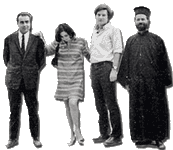 Dimitri used a delightful flowery language, he called me louloudi mou (« my dear little flower »), katsikaki mou (« my dear little goat ») and invited me, from time to time, to Munich for dinner. With him, I found again my ancient love for Greek language and culture, for this archaeology and mythology I had always enjoyed so much. He has since founded an Art Centre in Crete. . Dimitri used a delightful flowery language, he called me louloudi mou (« my dear little flower »), katsikaki mou (« my dear little goat ») and invited me, from time to time, to Munich for dinner. With him, I found again my ancient love for Greek language and culture, for this archaeology and mythology I had always enjoyed so much. He has since founded an Art Centre in Crete. . 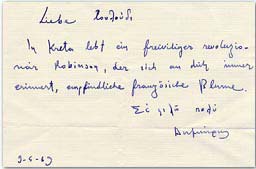
Bettina von Arnim
I discovered Bettina in Berlin. Her name was familiar to me, as her ancestor Bettina the First, was the muse of German poets such as Schiller and Goethe. My Bettina was a painter, and I loved immediately her paintings (I have one of them at home), reminding me of the drawings of Science-Fiction Author Ray Bradbury, whom I met while I was shooting my TV movie on Escapee from Future. Née en 1940 dans le Brandenboug, elle a fait partie du groupe Kritscher Realismus (« réalisme critique ») et vit aujourd’hui en France, dans le Lot.
Fernando Arrabal
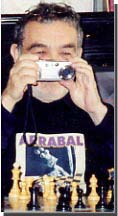 Spanish poet and play-writer Arrabal was one of my first interviews for the Express and for the Magazine Littéraire. He had just founded, at the time, the movement Panics (from the Greek word Pan which means “Whole”) with painter Alex Jorodovsky and my friend, the writer, painter and humorist Roland Topor. Pataphysican Satrape, Arrabal writes, paints and holds a salon, not far from my home, on the other side of the bridge, near the garden of Batignolles. Spanish poet and play-writer Arrabal was one of my first interviews for the Express and for the Magazine Littéraire. He had just founded, at the time, the movement Panics (from the Greek word Pan which means “Whole”) with painter Alex Jorodovsky and my friend, the writer, painter and humorist Roland Topor. Pataphysican Satrape, Arrabal writes, paints and holds a salon, not far from my home, on the other side of the bridge, near the garden of Batignolles.
His Web site: http://www.arrabal.org/mag46.html
Père Arrupe, s.j.
When I was in Rome, for the shooting of my film on Jesuits for French TV, Father Calvez promised, if I were good, to introduce me as I had so passionately wished, to Father Arrupe, the “General” (Head) of the Order. I knew that, at the time of the bomb in Hiroshima, he was there, as a young physician and priest. After having tended and helped wounded and dying people, without any break all the night long, he celebrated the first mass of that dreadful first post-bomb morning in the ripped apart cathedral. For me, very naively, he was a figure like staretz Zosime in “The Brothers Karamazov”, one whom I could ask about the (dark) question of Evil. Father Calvez was a man of his word: I remember this long meeting in Rome, in 1976, the long hands of Father Arrupe and his sweet, low voice, his thrilling glance, as if he was the only one able to read a score, that he was the only one able to interpret. Something he wrote (I quote it in my CD ROM on Jesuit Pedagogy, summed up what I felt and heard in the secrecy of that room of Borgho Santo Spirito:
The love which a Christian feels for humanity will push him to get on the locomotive to drive the train in the right direction. It implies mastering the commands, knowing the territory, the systems of control of shunting, and also the devils who are operating them. In the locomotive, it’s not enough to be a man of good will, or one of those learned people from whom fame radiates. Wise people are needed, and also exorcists who know how to conjure the devils driving the world.
From time to time, making sharp turns and detours through abrupt paths could be the only way to avoid a catastrophe. One has then to face angry passengers who, sitting at the rear of the train, appreciate a more reassuring driving technique. The Christian has never to forget the fundamental ethics, without getting caught up in the issues along the way, which would again amount to abandoning the locomotive and attention to the future, to be, on the contrary, shut away in a laboratory wagon, in the middle of the train, as far from reality as the rear van.(Extract by Pedro Arrupe, s.j., To Promote Justice, special issue of Vie Chrétienne n°200)
Maud Augustin von Conta
From Maud arose in a way my passion for Haiti, which was stirred again when I came to know, later, Mathilda Beauvoir, wonderful dancer of the « Theatre of the Nations » and revered mambo (Voodoo priest), and revived once more when I wrote my multi-volume Encyclopaedia on The West Indies and Guyana, Arawak, and I met Jolicoeur. Maud was the first to have revealed to me the feeling of poetry in any Haitian, this cooing accent, and above all, this laughter and wisdom in every circumstance: « Churches, she said, have been created by God in order to give a “salon” to poor people, so that they can be dressed smartly once a week, on Sunday. » She shared my room in Grafrath, when we studied at the Goethe Institute, in the 1960s. Then, I saw her again, married to a German, in Munich, she has two wonderful children. Maud is always as beautiful and cheerful, with her giraffe’s eyes and her ringing laugh, nostalgic and philosophic.
Kosta Axelos
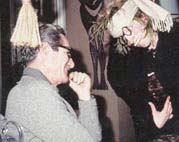 Director at Minuit Publishing Cy, specialist in Heidegger’s philosophy, Kosta Axelos, himself an eminent philosopher, is playing here, at a party in my home, with the Canadian clown Chatouille (Sophie Cotté). Director at Minuit Publishing Cy, specialist in Heidegger’s philosophy, Kosta Axelos, himself an eminent philosopher, is playing here, at a party in my home, with the Canadian clown Chatouille (Sophie Cotté).
Sylvie Barnaud
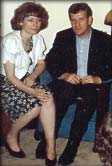 Sylvie (here with Claude) was my very young neighbour when I invited her to work with me on the book by Jacques Boedels, that I intended to publish out of the Antebi Publishing Cy. Efficient and quick to understand, with a great sense of public relations, she did a very good job. She later became Captain in the Police. Sylvie (here with Claude) was my very young neighbour when I invited her to work with me on the book by Jacques Boedels, that I intended to publish out of the Antebi Publishing Cy. Efficient and quick to understand, with a great sense of public relations, she did a very good job. She later became Captain in the Police.
Janine de la Bastide
Is was Anne de Boismilon who introduced me to Janine de la Bastide, chatelaine of Pressac. We owe to her irreplaceable and matchless moments of magic. She had always received us with an unfailing generosity and enthusiasm, despite the worries (specially money worries) that she had more and more.
 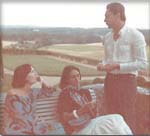 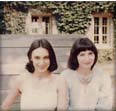 On the left, Janine with, in medallion, the castle. In the middle, Anne and me, like model young women. On the right, with Jean Repiquet, who became, later, the Secretary of the French Bar. Below, a general view of Pressac, and of the dining room where dear old Maria cooked for us delightful meals. On the left, Janine with, in medallion, the castle. In the middle, Anne and me, like model young women. On the right, with Jean Repiquet, who became, later, the Secretary of the French Bar. Below, a general view of Pressac, and of the dining room where dear old Maria cooked for us delightful meals.
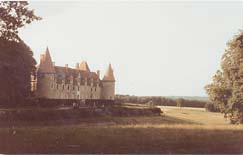 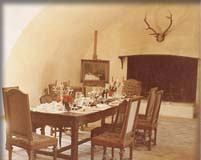
Stéphane Battistaki
 Short encounter with a handsome young Greek actor (he played a role, if I remember well, in Elektra of Cacoyannis) in the course of the Autumn of 1966 in Mykonos. He invited me for a drink on the circular rooves of the tiny whitewashed churches, and said : « You see how close to the sky we are ! ». Short encounter with a handsome young Greek actor (he played a role, if I remember well, in Elektra of Cacoyannis) in the course of the Autumn of 1966 in Mykonos. He invited me for a drink on the circular rooves of the tiny whitewashed churches, and said : « You see how close to the sky we are ! ».
|



